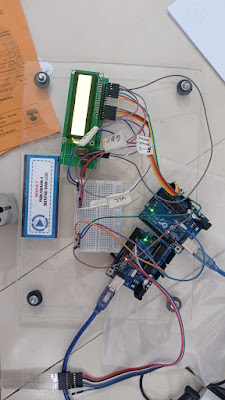LAPORAN AKHIR 2
PERCOBAAN 2
1. Alat & Bahan[kembali]
a. Arduino Uno
b. Dipswitch
c. Seven Segment
d. Jumper
e. Breadboard
2. Rangkaian [kembali]
3. Flowchart[kembali]
4. Listing Program[kembali]
//Master Arduino
#include<SPI.h> //Library for SPI
int dip[] = {2,3,4,5,6,7,8,9};
int dipvalue[] = {};
void setup (){
Serial.begin(9600); //Starts Serial Communication at Baud Rate 115200
for(int i = 0; i < 8; i++){
pinMode(dip[i], INPUT_PULLUP);
}
SPI.begin(); //Begins the SPI commnuication
SPI.setClockDivider(SPI_CLOCK_DIV8); //Sets clock for SPI communication at 8 (16/8=2Mhz)
digitalWrite(SS,HIGH); // Setting SlaveSelect as HIGH (So master doesnt connnect with slave)
}
void loop(void){
byte Mastersend;
int x = 1;
for(int i = 0; i < 8; i++){
dipvalue[i] = digitalRead(dip[i]);
if(dipvalue[i] == LOW){
x = dip[i];
}
}
digitalWrite(SS, LOW); //Starts communication with Slave connected to master
Mastersend = x;
Serial.println(Mastersend);
SPI.transfer(Mastersend); //Send the mastersend value to slave also receives value from slave
delay(1000);
}
//Slave Arduino:
#include<SPI.h>
const int segmentPins[] = {9, 8, 7, 6, 5, 4, 3, 2};
volatile boolean received = false;
volatile byte Slavereceived;
int index;
void setup(){
Serial.begin(9600);
for (int i = 0; i < 8; i++) {
pinMode(segmentPins[i], OUTPUT);
}
SPCR |= _BV(SPE); //Turn on SPI in Slave Mode
SPI.attachInterrupt(); //Interuupt ON is set for SPI commnucation
}
ISR (SPI_STC_vect){ //Inerrrput routine function
Slavereceived = SPDR; // Value received from master if store in variable slavereceived
received = true; //Sets received as True
}
void loop(){
Serial.println(Slavereceived);
if(received){//Logic to SET LED ON OR OFF depending upon the value recerived from master
displayCharacter(Slavereceived);
delay(1000);
}
}
void displayCharacter(int ch) {
byte patterns[10][7] = {
{0, 0, 0, 0, 0, 0, 1}, // 0
{1, 0, 0, 1, 1, 1, 1}, // 1
{0, 0, 1, 0, 0, 1, 0}, // 2
{0, 0, 0, 0, 1, 1, 0}, // 3
{1, 0, 0, 1, 1, 0, 0}, // 4
{0, 1, 0, 0, 1, 0, 0}, // 5
{0, 1, 0, 0, 0, 0, 0}, // 6
{0, 0, 0, 1, 1, 1, 1}, // 7
{0, 0, 0, 0, 0, 0, 0}, // 8
{0, 0, 0, 0, 1, 0, 0} // 9
};
if ((ch >= 0 && ch <= 9)) {
// Get the digit index (0-9) from the character
int index = ch;
// Write the pattern to the segment pins
for (int i = 0; i < 7; i++) {
digitalWrite(segmentPins[i], patterns[index][i]);
}
}
}
5. Prinsip Kerja[kembali]
Pada percobaan kali ini menggunakan dipswitch sebagai inputnya. Yang akan dihubungkan ke arduino 1 (master) dan dari arduino 1 akan melakukan komunikasi dengan arduino 2(slave). Yang akan menampilkan output pada seven segment.
Pada rangkaian ini jika tidak ada arduino yang aktif, maka pada seven segment akan menampilkan angka 1. Dan jika dipswitch aktif maka angka yang akan di tampilkan seven segment adalah angka tertinggi dari dipswitch yang aktif+1.
6. Video Percobaan[kembali]
7. Download[kembali]















